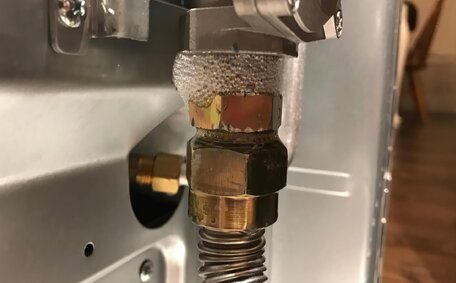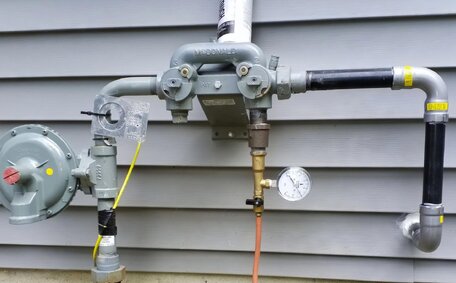Introduction to Gas Hot Water Systems
Many homeowners in Kenthurst, Sydney, prefer gas hot water systems for their high efficiency and dependability. In contrast to electric storage systems that heat water in a tank, gas systems only heat water as required, ensuring energy is used only when necessary.
We’ll compare different types of system like storage tanks versus continuous flow, analyse operating expenses, energy use and environmental impact. Discover how gas hot water systems stack up against electric ones, explore installation and maintenance considerations, and learn about the synergy of combining gas with solar power.
By the end, you’ll be able to determine if an electric gas hot water system meets your energy-saving and environmental goals.
Types of Gas Systems: Storage vs Continuous Flow
Gas hot water systems come in two main varieties: storage tank models and continuous flow designs. Storage tanks heats water and store it in an insulated reservoir, ready for when it’s required. Continuous flow units heat the incoming cold water instantly and as needed.
Water storage tanks are better suited to residences with foreseeable daily hot water needs. Since the water is pre-heated, storage tanks can handle multiple hot water needs at once. A primary disadvantage is that they might need more energy and the hot water may run out if the call for hot water surges past tank capacity.
When choosing between gas storage and continuous flow systems, consider your typical hot water needs; storage tanks are ideal for busy households, while continuous flow systems are better for homes with fewer residents.
Energy Efficiency and Running Costs
When it comes to making a choice, home energy use, water heating accounts for about 21% of the average household electricity bill. Choosing an energy-efficient gas hot water heater can significantly reduce your utility bills.
Consider gas systems that meet or exceed a 5-star energy rating to significantly reduce energy costs compared to electric models. To save money on energy bills with a gas hot water system, consider key factors like:
- Highly efficient gas burners in gas systems provide quick water heating, outperforming electric elements.
- Minimal heat loss from storage hot water tanks or pipes ensures greater efficiency
- Continuous flow units only heat water on demand, ensuring continuous hot water is available whenever required
Thanks to their efficient energy use, gas hot water systems are often more cost-effective than traditional electric models. You’ll also produce fewer greenhouse gas emissions compared to electric water systems.
Actual running costs vary with factors such as your household’s hot water usage and the size and model of your system. But gas is often cheaper than alternative fuels when seeking ways to reduce your energy bills and environmental footprint.
Installation and Maintenance Requirements
Installing a new hot water system requires connecting it to your existing natural gas or LPG supply lines. If your gas piping hasn’t been updated in over 15 years, modifications like upsizing the pipes may be needed to provide adequate gas flow.
The installation must feature safe exhaust flueing to vent combustion by-products appropriately. It’s crucial to hire a qualified tradesperson, especially for power installations, to ensure compliance with strict safety regulations.
Gas electric hot water heaters, known for their high output, typically require minimal maintenance. Annual inspections are recommended to check gas pressures, flue function, pipe condition, and system efficiency. Periodic replacement of worn components and descaling the heat exchanger every five years can avert issues and extend system longevity.
Regularly serviced gas hot water systems can last more than 15 years. Despite a higher initial cost than electric systems, the reduced need for repairs and higher efficiency of gas systems offer greater value over the long term.
Environmental Impact and Emissions
When analysing the environmental impact of gas hot water systems, the main consideration is greenhouse gas emissions produced from burning natural gas. While gas, as a fossil fuel, does emit greenhouse gases, it’s still eco-friendlier than several alternatives.
According to Australian Government data, gas produces around 50% less greenhouse emissions per unit of energy than an electric hot water system powered by coal-fired electricity. Gas becomes a lower-emission choice when used in conjunction with renewable energy sources like solar photovoltaics (PV).
At installation, steps like correctly sizing the unit and ensuring proper flueing can minimise its environmental impact.
Over time, wear and tear can also cause components like pilot lights and burners to operate inefficiently, increasing emissions. Regular service and maintenance are crucial for reducing the environmental impact throughout the lifespan of your hot water system.
Ongoing developments in low-carbon renewable gases promise further sustainability improvements.
Upfront and Operating Costs
In terms of initial costs, gas hot water systems are generally more expensive than electric storage units. Nevertheless, prices have decreased recently, with entry-level continuous flow gas systems beginning at approximately $1,100 installed.
The complexity of connecting your new system to the existing gas and water infrastructure can cause installation costs to fluctuate. Any modifications needed to upgrade gas pipe sizing will increase expenses. Generally, a household may incur $1,500 - $2,000 for installing a new gas hot water system.
In terms of operating costs, gas hot water is one of the most affordable options. As gas prices are typically lower than those of electricity, utilising gas for water heating can save the average family about $300 yearly compared to electric systems. Additional operating costs remain low, with routine preventative maintenance averaging about $150 per year.
Although they have a higher up-front cost, deluxe heat pump systems tend to have lower aggregate expenses over a decade. Rebates of up to $1,000 are available to offset installation costs, thanks to government support. From a financial perspective, integrating gas with solar water heating emerges as a prudent long-term option.
Using Gas to Boost Solar Hot Water Systems
Integrating pump hot water systems with gas and solar energy can effectively guarantee a dependable stream of hot water. Pump water systems, including solar hot water systems, rely on sunlight to heat water, which can be unreliable during cloudy weather or winter months. With a gas booster, you can achieve optimal water temperature even during periods of low solar gain.
Gas boosters are usually continuous flow units paired with a solar storage tank. They automatically ignite to heat pump water as it passes through to the taps, but only when the water in the solar tank drops below a set temperature. This provides hot water 24/7, even with little to no sun.
Many families might notice their gas booster activates 20-50% of the time to complement the solar system. Matching your solar storage and gas booster capacity to your average hot water needs can further decrease this dependence. Choosing a larger solar tank and a smaller gas setup reduces operational costs but raises initial expenditures.
Using gas as a backup for solar when needed, families enjoy lower running costs than with conventional electric systems. Solar gas systems thus become an investment that reaps long-term benefits, being financially viable and eco-friendly.
Sizing Your System Based on Household Demand
Selecting the appropriate size for your hot water system is critical for efficiency and cost-effectiveness. The required size depends on your household’s average daily hot water consumption.
- For 1-2 residents, a 16-20 litre/minute continuous flow system is recommended.
- For 3-4 residents, opt for a 20-26 litre/minute continuous flow system.
- For a large family of 4 or more, a 26+ litre/minute continuous flow or a water tank with 400 litre capacity is suitable.
Kenthurst’s high-altitude climate may result in a 30% rise in hot water use compared to the average across Australia. A family of four in this region might require a 26-32 litre/minute continuous flow unit for sufficient hot water supply.
Monitor your household’s daily hot water consumption for a week to calculate your specific requirements. Identifying peak usage and maximum flow rates can help guarantee that your new gas system will accommodate daily household demand.
A gas unit that’s too small results in tepid showers and elevated energy bills. Conversely, an oversized unit leads to wasteful gas consumption through unnecessary reheating. Correctly sizing your hot water system can diminish operating costs and environmental impact throughout its service life.
Conclusion: The Cost-Effectiveness of Gas
Gas hot water systems present economic benefits for many Kenthurst homes, including energy efficiency, reduced operating costs, and durability.
The on-demand water heating capability of gas systems minimizes energy wastage.
Combining gas with heat pumps and solar energy gives homeowners the best of both worlds: a constant hot water supply and minimal emissions. Due to Kenthurst’s climate, households typically require 30% more hot water, necessitating appropriate sizing of gas units.
To find a hot water system that suits your home, reduces environmental impact, and cuts household costs, get in touch with our Kenthurst Plumbing team today.






